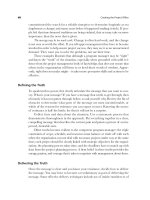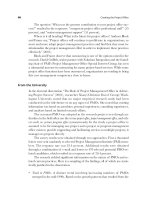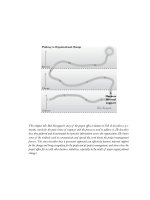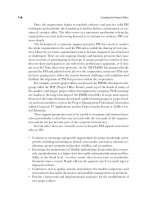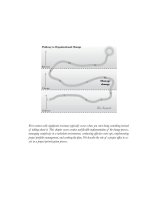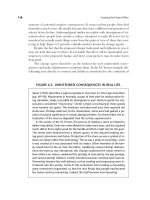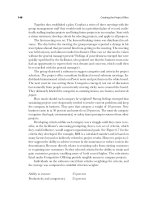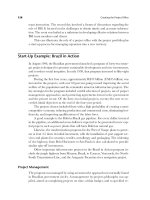Tài liệu Creating the project office 6 ppt
Bạn đang xem bản rút gọn của tài liệu. Xem và tải ngay bản đầy đủ của tài liệu tại đây (155.91 KB, 10 trang )
will be impossible. Changing systems is also difficult as much has been invested in
current systems, and the people who run them probably favor the status quo. Fi-
nally, getting the support of department directors has been notoriously difficult
over the history of the project management movement. It is here that many
change processes fail. Even when procedures have proven to be effective and the
necessary skills have been developed, the structures, systems, and supervisors do
not yield to change, and the process fails.
For this reason we opened this chapter with the reference to Dante. The sign over
the door to Hell warned him to “abandon hope.” Yet we believe there is reason in-
stead to “abandon despair”—there is a process and help to address the difficult issues.
Phase 3: Making Change Stick
By this point in the change process, the value of moving to enterprise project man-
agement has probably been proven many times over. Project managers have been
well trained, mentored, and supported, and good project manager practice has
become the norm. It may seem that the new practices have taken root and now
define the way things are done in the organization. However, experience indicates
that this is not necessarily true. Old habits die hard and the old culture lies just
below the surface, constantly ready to reassert itself.
Kotter (1996, pp. 145–147) described an aerospace company where a five-
year change process yielded an increase in revenues of 62 percent and an increase
in net income of 76 percent. The driver of the change, the division general man-
ager, retired—feeling that the changes had been made, the results impressive, and
the work had been done. Very soon, many of the changes that were put in place
began to unravel; many small adjustments were made, mostly imperceptible.
Within twenty-four months, some practices had regressed to where they had been
four years before. Shortly thereafter the first major performance problems began
to emerge. Kotter argues that this happens because “some central precepts in the
division’s culture were incompatible with all the changes that had been made. As
long as the division general manager and the transformation program worked day
and night to reinforce the new practices, the total weight of these efforts over-
whelmed the cultural differences. But when the division general manager left and
the transformation program ended, the culture reasserted itself ” (p. 146).
The teamwork and cross-organization cooperation necessary for enterprise
project management are antithetical to the reality experienced in most organiza-
tions. For this reason it is a good bet that the changes necessary to implement en-
terprise project management will be quite incompatible with the organization’s
culture. Even if systemic changes are made in the organization, the old ways will
still linger for many organizational generations.
Culture change is an extremely long and complicated process. It means
changing the way people construct their reality. People must experience the con-
28 Creating the Project Office
nection between new action and performance improvement on many different
occasions and over a sustained period. The changes must be passed on from one
generation to another, and this will probably have to happen several times before
the organizational culture adjusts to the new reality. Process cannot be said to be
complete until the day when there is no one left in the organization who can re-
member doing things any other way.
By the beginning of the third phase of the change process, a strategic project
office should have been established. The people in this office are in a unique po-
sition to lead this final phase of the change process. An important aspect will be
their ability to follow a project from inception all the way until the end of the
product that was produced by the project. In the past, the costs for the project
were normally counted in one part of the organization, perhaps R&D, while the
benefits of the project’s product were counted in a different part of the organiza-
tion, perhaps in Marketing. Projects were seen as an expense rather than as an in-
vestment, so the return on investment in the project was rarely calculated. With
a changed accounting system and a strategic project office positioned high enough
in the organization, the accounting for the project investment as well as the re-
turn on that investment now come together in one place. This information will
help develop portfolio management and project selection procedures as well as
pave the way for developing a venture project management program, where
project managers feel responsibility beyond the completion of the project itself
and throughout the life of the project’s product.
With this final change, project management will be seen as much more than
just a set of techniques to complete projects on time and on budget. Project man-
agement practices become totally intertwined with business management prac-
tices—project and business management will be seen as the same thing.
Chapters Ten and Eleven contain a discussion of the difficulties of cultural
change, suggestions for implementing cultural change, a description of the
changes that will be necessary for venture project management to become a real-
ity, and suggestions for implementing those changes.
Summary
This chapter presents many concepts and ideas regarding planned organizational
change, the three phases of that change, the role of the change agent during those
phases, and the progression of project office development to support the entire
change process. The box in Figure 1.3 presents a summary of these ideas in cap-
sule form. This can be used as a one-page guide to the entire organizational
change process. Details concerning the steps in this process are given in subse-
quent chapters.
Leading Organizational Change 29
30 Creating the Project Office
Change Change Agent
Phase Processes Project Office Development
Create Establish a sense Benchmarking (continual function).
conditions of urgency. Organizational vision.
for change Value proposition.
Develop political Stakeholder analysis.
acumen.
Create a guiding PM council with organization-wide
coalition. representation.
Powerful executive sponsor.
Develop a vision PM office vision, what it will do.
and strategy. Strategy, start small, expand with success.
Communicate Meet with all organization constituents.
that change vision. Generate their enthusiasm.
Make change Generate short- Apply standard process to some immediate
happen term wins. problem. Show value.
Level 1–PCO.
Develop broad- Develop constituency through training,
based action. mentoring, consulting, developing a career
path.
Level 2–PMCOE.
Consolidate gains Reorganization to establish a CPO.
and produce Level 3–strategic PO.
more change. Change reward system; develop portfolio
management and venture project management.
Make change Make project Change organization culture by providing
stick management leadership, training, means, and the motivation
the norm. to make the change the new reality.
FIGURE 1.3. CHANGE PROCESS FOR PROJECT-BASED ORGANIZATION.
Following the process outlined in Chapter One, the first step in implementing organizational change
is creating a sense of urgency for that change. To implement a project office system that spans an
entire organization requires creating a sense of urgency among many members of the organiza-
tion. A short-term sense of urgency can be created by pointing to a clear danger, something that
threatens the future of the organization. However, experience indicates that this urgency often does
not last once the danger passes. In this chapter we give longer-lasting ways to create an organi-
zation-wide sense of urgency regarding the need to implement a project office. These consist of
establishing that the office will add value to the organization, comparing your organization’s project
management practices to those considered the best, and describing a desired future of the organi-
zation that is based on developing project management as a core competency.
1.
3.
4.
5.
6.
7.
8.
9.
10.
11.
Refreeze
Change
Unfreeze
2.
Urgency
and value
Pathway to Organizational Change
33
CHAPTER TWO
CLEAR DANGER: CREATING A SENSE
OF URGENCY AND ECONOMIC VALUE
Brutus is an honorable man.
S
HAKESPEARE
C
hapter One describes how organizational change efforts seem destined to fail
unless those directing the change can establish a sense of urgency for that
change. Pointing to a clear danger is a useful technique for getting people’s at-
tention, but that attention often wanes once the immediate danger has passed. To
build a longer-term sense of urgency we develop that step plus three additional
actions for consideration in this chapter.
1. Use the clear danger. The first suggestion is to concentrate on the set of circum-
stances that brought forward the need to establish better project management
in the first place, normally a project crisis or missed opportunity, and to show
how establishing a project office will help to avert such crises in the future.
2. Add value to the organization. Once it is shown that future crises can be averted,
the next step is to focus attention on the longer-term benefits of the project of-
fice to the organization. This is best done by developing a value proposition
indicating how the office will make the organization better and more successful.
3. Benchmark current organizational practices. To demonstrate this added value, con-
sider benchmarking the current practices of your organization against those
of industry leaders who have already established a project office system. If the
benchmarking shows that your organization is falling behind the industry lead-
ers, a sense of urgency for better project management will increase quickly.
Y
4. Describe a desired organization. To begin the focus on benefits of organizational
change, it is useful to create a picture of the future organization, a description
of what the organization could be like once the change process is completed and
project management established as a core competency. When people see how
that type of organization will function and what it can accomplish, they will want
what they see, and there will be an urgency to start developing it immediately.
Developing a Clear Danger
Implementing a project office will require cooperation among many different parts
of the organization, often among organizational entities that typically do not co-
operate with each other. Developing a clear danger to the survival of the organi-
zation is one well-known way of fostering cooperation and even getting people to
temporarily suspend long-held beliefs to work toward organizational survival. For
example, in Morality and Expediency, Bailey (1977) describes a situation where pro-
fessors agreed to fabricate enrollment in certain courses so they would not lose
state funding. The author points out that one core value of the professor is to tell
the truth, and indicated that any professor who published a paper with lies would
be severely chastised. However, the group was willing to suspend that morality for
the expediency of maintaining a higher level of state funding.
Similarly, the members of many university departments fight each other con-
tinually, downgrading the field of study in any department but their own. How-
ever, when the state funding agency appears with a mandate for interdepartmental
cooperation, departmental members find themselves able to come together to give
a unified front and present many plans for interdisciplinary research. Of course,
those plans evaporate once the funding is secure and the usual interdepartmen-
tal animosities reemerge.
34 Creating the Project Office
Establish sense of
urgency— clear danger
• know current problems
• add value to the organization
• compare to the best
• describe desired future state
Leading
Organizational
Change
to PBO
Create guiding coalition—
powerful forces
Develop vision and strategy—
focus
Manage the change—
short-term wins, broad-based action,
consolidate gains
Develop broad-based action—
keep moving, implementing
Make change stick—
new PBO culture
The tale we tell
Communicate the change vision—
tell the tale
Staff and operate—
In or out?
These examples show a typical pattern in response to threats. That is, people
with a wide variety of often conflicting interests are able to unify and work together
when there is a clear danger. Once the sense of danger has passed, however, old
feuds and the old ways quickly reassert themselves. This response illustrates the
type of unity of purpose that change agents would like to generate to initiate any
change process. The groups of people to be convinced range far and wide across
the organization, each with its own set of problems to solve and each with its own
set of changes in mind. Your initial task as a change agent is to create a sense of
urgency concerning the need for enterprise project management and a project of-
fice that is so strong that groups with diverse agendas would be willing to abandon,
or at least temporarily suspend, their own change efforts in order to support yours.
Spinning Your Wheels
As noted earlier, the desire to increase project management ability often results
from a series of project failures. In many organizations, the first response to these
failures is to send a few engineers out for training in project management. The
assumption here is that project management is a skill that can be easily learned
and then practiced in the organization. The reality is that although project man-
agement skills can be learned easily enough, those skills are so antithetical to the
way most organizations function that they are not easily applied. In fact, when
engineers return to the organization, they find that their newfound skills are so
strange to organizational beliefs that attempts to practice those skills are actually
seen as career-limiting moves. For example, organization members may look
askance when the engineers suggest time for project planning, they may walk out
of meetings set up to agree on project goals, and will often bristle with indigna-
tion at any suggestion that people work full time on one project only. As a result
of such responses, newly trained engineers either give up trying to practice project
management or leave the organization. Either way, the organization experiences
yet another failure in project management, this time with the additional pain of
spending money for training and getting nothing in return.
At some point we would hope it becomes clear to upper managers that project
management is more than just a set of skills; it is an approach to doing business
that requires wholehearted organizational support. At this point the concept of a
project office may be considered. Successive failures may warm people to the idea
that there is a need for a concentrated and dedicated group of people to system-
atically develop a project management capability within the organization. This
realization may come at the upper management level or may arise from a
groundswell across the organization. The initial urgency will be to prevent future
failures and stop spending all that money for nothing.
Clear Danger 35
The causes of project failure are fairly well known: usually some combina-
tion of lack of a clear goal, lack of following a project management methodol-
ogy, lack of top managers’ support, lack of interaction with customers and end
users, or lack of trained personnel to manage the project. The change agent needs
to be ready to show how the project office addresses these deficiencies. Developing
methodology, working to increase upper management support, interacting with
customers and users, and training project managers are often introductory steps
that many project office managers take in order to attack the most urgent orga-
nizational problems. In addition, these functions are known to be critical factors in
project success (Dai, 2001). The change agent team could thus consider imple-
menting these functions as a first step in their implementation plan.
Some Problems with Minimizing Cost as a Project Office Goal
A project office may be pushed to minimize costs on projects. Excessive cost might
be considered part of the clear danger. Is this a viable strategy? While it may be
helpful to get people’s attention by concentrating on minimizing costs, this initial
concentration could be detrimental for the long-term future of a project office
and the organization. It will not help the project office to get a reputation of being
a watchdog for management. Also, this concentration aligns the project office with
an old perception of project management, one that will not serve the office well
in the future.
In earlier days, project management was sold as a way to minimize cost. It
was touted as a set of techniques that would enable project managers to deliver a
specified outcome at a specified time and at a minimum cost. These are the triple
constraints, the basis for early project management practice. Over time it has be-
come apparent that the triple constraints are too constraining and that they often
lead to poor decision making on projects. But since people in organizations con-
tinue to emphasize the need to minimize costs, project management techniques
stay mired in the triple constraints. This is one reason why project management
seldom concerns top managers in the organization. They see it as a set of tech-
niques for minimizing cost, not as a way of operating projects to help them achieve
strategy and add value to the organization.
This is an important issue in the framing of both the problem and the pro-
posed solution. A project crisis is good for gaining attention, but framing the
project office merely as a response to crisis will be detrimental in the long run. If
the project office is seen as a watchdog group there to oversee project spending,
it develops a negative image and there is little chance of getting cooperation from
project managers and other organization members. There is also little chance that
upper managers will associate the office with achieving strategy and change. In
36 Creating the Project Office
framing the function and purpose of the project office, first understand people’s
concerns with costs and indeed address that concern as a part of the purpose.
Then move the function of the project office to adding economic value.
Costs are often a political football. Large construction projects such as a
Channel Tunnel or the Boston “Big Dig” are often chastised for going as much
as 500 percent over budget. However, the original budget figure is probably a lie,
a figure used to get voter approval for the project. Once the project is under way,
true costs emerge. However, since the project is already under way, voters usually
approve spending the extra money. Politicians often feel that the people will not
vote for the project if they knew how much it is really going to cost, and they may
well be correct. And politicians are not the only ones who underestimate project
costs in an effort to see a project initiated. It also happens in organizations. This
indicates that preliminary cost estimates are an important first place to look when
there is concern with cost control. This also indicates that an important additional
function of a project office is to work to produce reliable and truthful estimates of
project costs whenever projects are first being considered.
“Brutus is an honorable man” is Mark Antony’s line in Shakespeare’s Julius
Caesar. He repeated it during his oration at Caesar’s funeral. He used it to build
rapport with the audience who believed in Brutus. However, Brutus murdered
Caesar. By the end of the oration, the audience ran Brutus out of town.
For our purposes, Brutus is the budget, an emphasis on project costs. Propo-
nents of a project office need to acknowledge that costs are important. Draw a
lesson from Mark Antony’s speech as a brilliant persuasive tool. Help people come
to realize that emphasis on budget is shortsighted. Clear dangers are all around,
and narrow focus on costs is a big one. The real honor is in creating value. Do the
right thing and the money will follow is the first law of money.
People in organizations say they want to minimize cost, but do they really?
Despite all the discussion about the cost of projects that failed, it is usually plain
to see that cost would not be a factor had the projects succeeded. It seems a rule of
life that for successful projects the costs cannot be remembered while for failed
projects the costs cannot be forgotten. It is not the cost of the project that worries
people, it is the cost of the failure. This is another indication that the emphasis of
the project office should be on developing practices that minimize the chance of
project failure rather than on framing rules to minimize project costs.
People in organizations say they want to minimize cost, but do they really?
An easy retort to this idea is that it is easy to minimize project costs in any orga-
nization—just don’t do any projects. With no projects, project costs are zero. This
is quickly seen as folly; people want the benefits that the projects produce, and
they would like the benefits to outweigh the costs. It is easy to argue that firms
cannot succeed by minimizing cost, they succeed by adding value. The same is
Clear Danger 37
